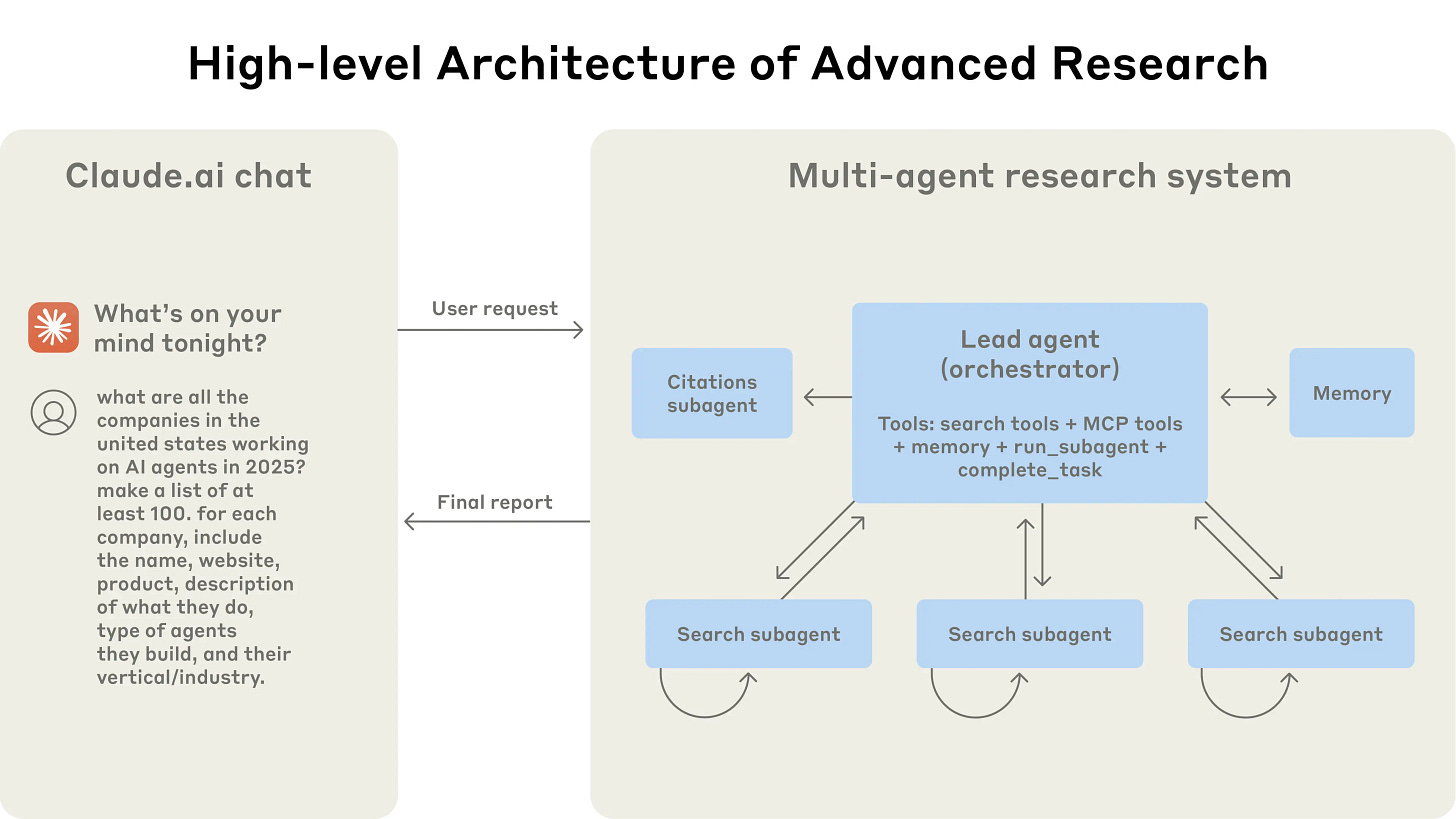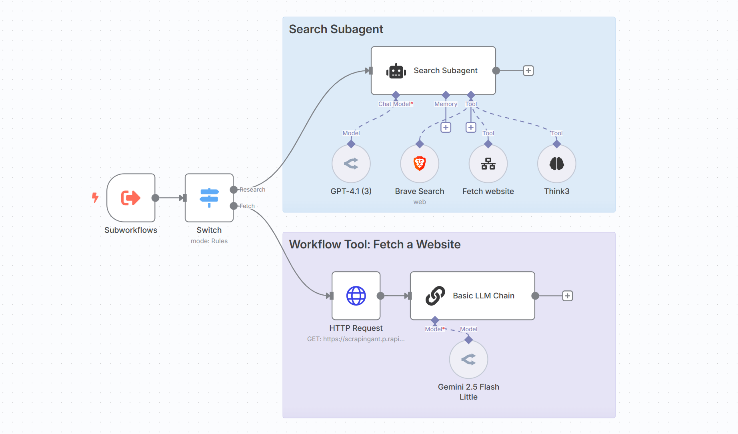I Copied the Multi-Agent Research System by Anthropic. No Coding!
A deep research n8n template with step-by step instructions. You can use those techniques for competitor analysis, outbound marketing, or lead generation.
Hey, welcome to the freemium edition of The Product Compass newsletter.
Every week, I share actionable tips, templates, resources, and insights for PMs.
Here’s what you might have recently missed:
Consider subscribing or upgrading your account for the full experience:
Many subscribers have been asking me how I built the Deep Market Researcher available on aigents.pm. I’ve been explaining that it was build with Lovable. And that the next time I would move the logic to n8n.
Just a few days ago, on Jun 13, 2025, Anthropic has published How we built our multi-agent research system in which they described their high-level architecture:

That’s similar to our Deep Market Researcher Agent architecture!
My first though: Can we repeat that without coding?
After a few days, I did that with n8n.
In today’s issue:
Multi-Agent Research System: n8n Demo
Building Blocks of Our Multi-Agent Research System
🔒 A Ready-to-Use n8n Template And Instructions
🔒 Unexpected: My Learnings
I encourage you to repeat the process. This will help you:
Develop a better AI Intuition.
Easily build other multi-agent systems to automate your work, e.g., market research, competitor analysis, outbound marketing, or lead generation.
Develop solutions for you AI portfolio. Just a few PMs can demonstrate that.
On Tuesday, I’ll also discuss the details and answer your questions during our Office Hours (Zoom).
Let’s dive in.
1. Multi-Agent Research System: n8n Demo
Here you can see how AI agents work together (no sound, you can skip the middle):
Here’s what happened:
The initial conversation with the user:
User: “Please compare Netflix”
Customer Support Agent: “Could you please clarify what aspect you would like to compare about Netflix? For example, are you interested in comparing Netflix to specific competitors, evaluating its content library, pricing, user experience, or something else?”
User: “Compare video streaming providers, such as Netflix. Market share, financial results, subscribers, value proposition, target market segments, unfair advantage, perspectives. Analyze 2023-2025.”
System: “We're generating your report. Your report will be available here: [link]”
Execution steps (high-level):
The user asked a question.
A Customer Support Agent clarified the user request and called a Lead Agent.
The Lead Agent analyzed the request, planned the tasks, and called 10 Search Subagents.
Each Search Subagent searched the web and analyzed ~10 websites. Next, it returned the results (findings, insights, facts, etc.) to the Lead Agent.
The Lead Agent analyzed the progress and concluded that one iteration was enough. Then it called a Copywriter Agent.
The Copywriter Agent prepared the final report. The report was converted to a PDF, and uploaded to Google Drive.
According to the logs, the entire process took 7m 10s.
The result (Google Drive): video_streaming_providers_(…)_2023_2025.pdf
2. Building Blocks of Our Multi-Agent Research System
There are several critical components:
User Interface
This time, I simplified the implementation and used native n8n forms to:
Initialize the workflow,
Ask clarifying questions,
Inform the user the report will be generated asynchronously.
You can adjust their styles with CSS. An alternative would be exposing webhooks that could be called, e.g., from Lovable.
Customer Support Agent
The process starts with a Customer Support Agent, whose goal is to clarify the user's request and define a clear research scope.
I didn’t see a similar element on a simplified Anthropic’s diagram. But one of the core principles of multi-agent systems is clear separation of roles. Talking to the user and orchestrating the research are different tasks. Overloading one AI agent wouldn’t make much sense.
Selected elements:
Simple memory → The agent remembers its past interactions in a short-term memory.
Structured output → The agent always responds with a specific JSON, so that n8n workflow can interpret the results.
OpenRouter → Rather than calling specific LLM providers, I send all requests to OpenRouter. It provides a unified API to access all the major LLM models.
Lead Agent (Orchestrator)
The Lead Agent’s goal is to prepare insights, findings, and learnings for a Copywriter Agent.
It analyzes the research scope and, depending on how complex the topic is, defines 3-12 research tasks for Search Subagents. Next calls them in parallel.
Lead Agent can reflect on the progress, define additional tasks, and call more Search Subagents to ensure it meets its objective.
Once it collects enough information, it forwards all its learning, links, and notes together with research context to a Copywriter Agent.
Selected elements:
Think tool → Even though an agent uses a Simple Memory, the Think tool encourages it to plan its work and store temporary artefacts, such as a research task list. Use when experimenting with non-reasoning models:
Search Subagent
The Search Subagent is aware of the broader research scope, but its goal is to collect detailed findings, insights, observations, and facts related to its specific tasks.
The Search Subagent:
Uses Brave Search to get a list of ~12 search results.
Selects 3-10 websites to analyze by the tool that extracts learnings.
Then, the agent reflects on the progress and repeats the process, if needed.
Finally, the agent combines all findings and returns them to the Lead Agent.
Selected elements:
Brave Search tool → To find websites (title, url) matching different search phrases.
Custom Fetch a website tool → To get findings and insights for a specific URL using a ScrapingAnt API and an LLM call.
Copywriter Agent
The goal of the Copywriter Agent is to prepare a final report by creating a well organized, consistent document in a markdown format.
Different notes, data, and findings might be inconsistent or poorly organized, so it might need several iterations before creating the final report.
Selected elements:
Markdown Master → An API to convert markdown into a PDF. The way it’s used is predictable, so instead of converting it into a tool, I orchestrated the call as part of the n8n workflow.
3. A Ready-to-Use n8n Template And Instructions
Keep reading with a 7-day free trial
Subscribe to The Product Compass to keep reading this post and get 7 days of free access to the full post archives.







